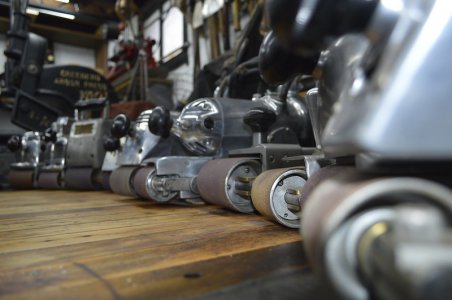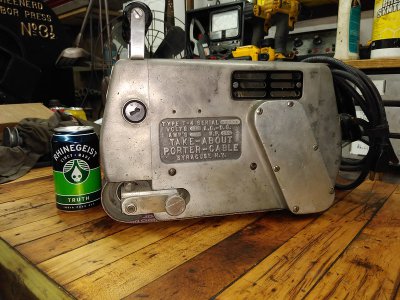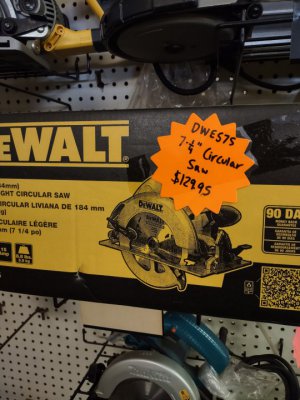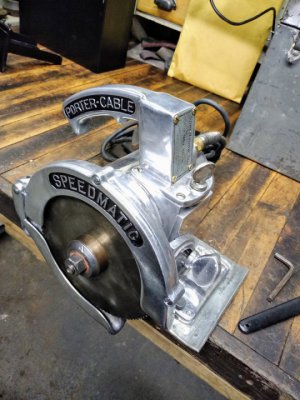Thank you, it's a combination of factors:
-I'm known as the Porter-Cable guy in some circles, so people are forever contacting me with leads on machines
-I prefer the basketcases to the pristine examples, so it's a lot less expensive to buy them
-I'm in the MidWest ( Ohio), where all the industry was, and machines are easy to come by
-I genuinely have no other hobbies
The woodworking area is next door ( our shotgun bungalow has the basement divided by a cinder block wall, making it relatively easy to keep dust off the toolroom machines and grit away from the woodworking equipment). The first machines you see if you walk into that room are the band saws,
View attachment 404759
The one on the left is a Syracuse Sander BS 20" band saw, made around 1919 before the company was purchased by ( you guessed it) Porter-Cable in 1922. It's the only known example, and a truly wonderful machine to use. The smaller machine is a 16" Hutchinson Speed Marvel band saw, made around 1925. Hutchinson was allied ( noone's sure f they were purchased, or merely became partners ) with Porter-Cable in the late '20s and early '30s.
There's also the Hutchinson Beaver combination woodworker,
View attachment 404760
a clever machine that can function as a radial arm saw, rip saw, jointer, or horizontal borer. I use it as a RAS more often than not, so it lives right next to the wood rack, as it's the first machine a board encounters on it's way to be made into something.
Right beside the Beaver is the Hutchinson Handy Hutch,
View attachment 404761
A 12" tilting table saw with an onboard 6" jointer. I've modified this machine quite a bit, from adding dust collection and a counterweight, ceiling-mounted guard to the Delta micro-set fence and rails and three-knife jointer cutterhead.
Then there's the Hutchinson Speed Marvel shaper,
View attachment 404762
a 2hp, 1" spindle monster. Next to the shaper is my gang drill,
View attachment 404763
a frankensteined machine made from a 1939 drill press head ( left), a 1946 drill press head( right, set up for mortising), and a 1949 gang drill base.
Then we hit the air compressor.
View attachment 404764
This is a 1945 Devilbiss that I'm almost finished restoring. I hydro-tested the tank, rebuilt the 130 pump, turned the armature in the repulsion start motor, and repainted it.
I have two wood lathes,
View attachment 404765
The main one being this 1947 Delta 1460 12". I also have a 1930s Delta 9" that I'm turning into a mini lathe with a variable speed D.C. motor.
Then there's all the sanders.
View attachment 404766
Left to right: a 1923-24 B-1 sander ( black) that's the only known example, and a complete heap that is going to take me years to rebuild, a late '40s B-3 10"x54" belt sander, a 1925-ish D-1 15" disc sander, a 1940s B-9 6"-54" belt sander, twin 116 6" bench grinders set up for lathe chisel sharpening/buffing, The c.1922 S-1 oscillating spindle sander, and lastly, my late'20s O-3 benchtop OSS.
I have another radial arm saw,
View attachment 404767
a 1950 Porter-Cable ERA radial arm attachment. With the right bracket in place, this machine can use any Porter-Cable saw of its day from 6" to 12", and also mount a router. Perched on the back is my Rockwell 9" miter saw, and to the left is my Delta 18" wedgebed planer.
Then there's my UBS shaper table,
View attachment 404768
It was built around 1948, and was the first of many Porter-Cable router tables.
I have my smaller ( 1/2" spindle) shaper, and my 14" jigsaw,
View attachment 404769
Both made for Porter-Cable by Henry Tools of London, Ontario, and only sold in Canada. The jigsaw has been retrofitted with a chopped and channeled Delta jigsaw stand, variable speed reeves drive and air blower, making it the most needlessly upgraded run-of-the-mill jigsaw you're ever likely to see.
This, however, is what it's all about,
View attachment 404771
View attachment 404772
I have a toolcrib that houses something North of 140 power tools, all made by Porter-Cable between the years of 1926 and 1963, when the Rockwell name took over ( Rockwell purchased Porter-Cable in 1960, but kept the name around for a little while) . I have nothing against Rockwell tools in general, and there are some models that I've stored over a hundred examples of, but I prefer the earlier tools for their quality, looks, and performance. I restore handheld and stationary Porter-Cable machines for people from all over the United States, and hope to do so for many,many more years.
-James Huston





